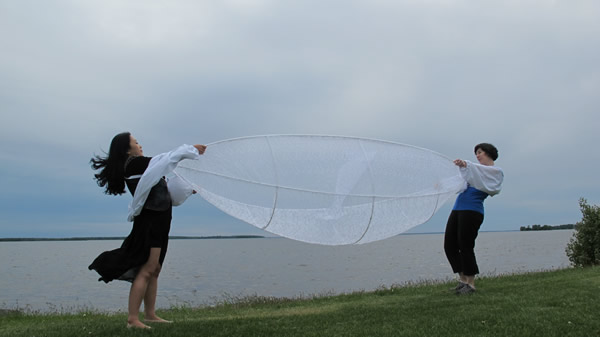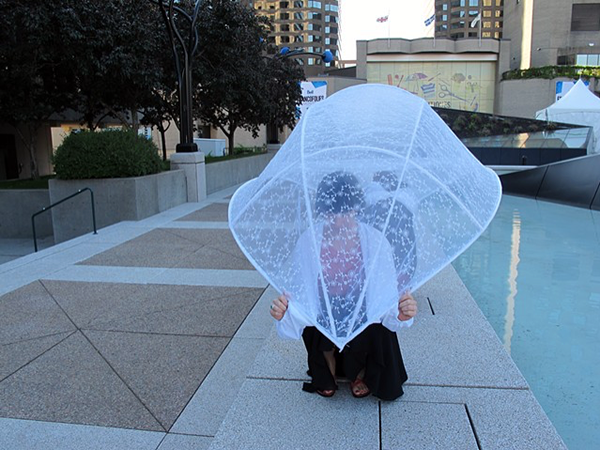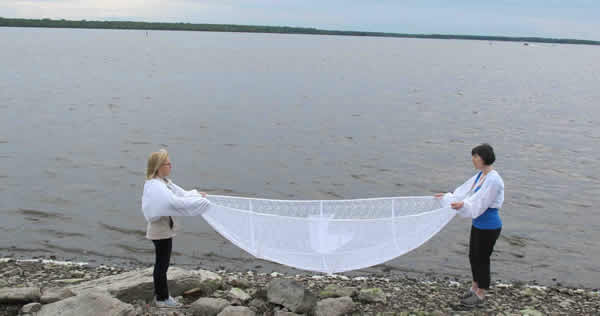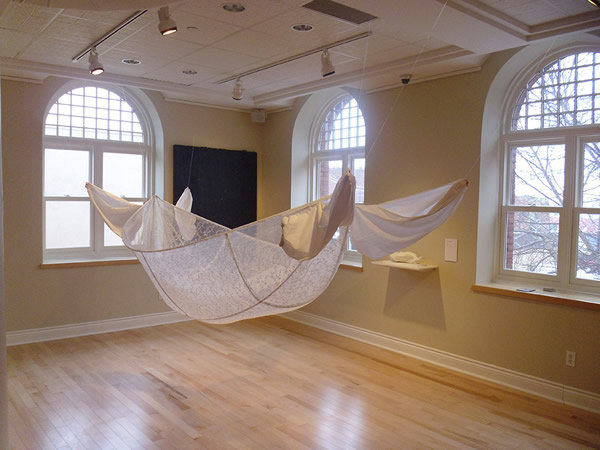
Fig. 1: Laura Endacott, Phantom Vessel. Portable Textile Sculture and Performance. Body accessory for two used in a series of performances. Tulle fabric and lightweight plastic poles are inserted in sleeves to structure this large-scale textile object. Participant (Young Ah Oh) and artist. Lachine, Quebec, 2013. side view.
As a visual artist, in my recent work, I have looked at the mother image in contemporary art. In spring 2013, I produced a portable sculpture that also acted as a body accessory for two people. My goal was to invite both biological and symbolic mothers to come on a series of walkabouts with me in and around Montréal. My hope was that we would exchange ideas, concerns, and experiences.
This photo essay speaks to the silent and symbolic resistance that my artwork explored. It explores serious concepts embedded in playful performances which politically engage ideas related to contemporary motherhood. It looks at the potential of performance art as an activist practice and it considers what undercurrents lie beneath the stillness of this art object. Much like a child’s toy, an art object is an opportunity to engage with something fundamental that lies in the deep waters of our socially constructed world.
The spring is a season of rebirth and renewal everywhere and the severity of Canadian winters gives extra significance to this time period. I chose this season to begin my investigation into the community of mothers not only for its metaphorical significance, but also because winter weather adds another level of difficulty to outdoor performances. My original idea had been to exchange ideas with my participants as we walked, wearing my portable vessel. I explained my intentions to them, confirming my hopes of having conversations about our experiences and our concerns, as they related to our maternal identities.
When came time to actually stage the performances, I found myself in different locations and attached to different women via my metaphorical art object. I had not been able to rehearse since it took two people to hold the boat. Each time I realized the walking would quickly stop and we began to move in response to one another, intuitively following each other’s movements. The words did not abound nor did they seem necessary. I initiated the first series of movements through eye contact or other subtle cues, such as pulling on the vessel, which resembled a canoe, to force my participant to look at me. Other times, I would leave some slack between us and wait to see if the other participant would direct us in some way. On several occasions my participants did prompt me to follow their lead in a similar silent manner, documented through digital photography.
In one instance, I turned around with my arms in the air and my partner did the same. The vessel became a symbolic protective structure that linked with the buildings around us, architecture for the body, a type of armature or protection from that which we resisted. Again I turned around but this time I crouched down and turned outwards. My partner did the same, creating the image of a fort or a tent. How interesting to take the maternal out of the domestic space and to play with the concept of the house or a dwelling.
There were pauses between movements. We stood together, in the moment and sensitive to the energy between us. The pauses were mostly short lapses that enabled the transition from one movement to another reflecting on the level of exploration suspended between us. The longer we worked together, the more rhythmic our transitions became.
Conversations did take place outside of the performances, which created a feeling of sisterhood in so far as our experiences seemed to have impacted our identities. The absence of verbal language created a peacefulness that was engaging and that united us in a powerful way.
I invited women of different ages and backgrounds to participate. I was not sure what to expect. As a researcher and as an artist, I was curious to discover what concerns would be more dominant and if we differed much from one another. Each time a woman and I began to interact, the words seemed to be cast aside. It was at once playful and engaging as we moved through a number of actions and responses. We engaged with each other through the textile sculpture.
The movements were slow as each one dissolved into another. With each progression, we seamlessly passed from one action to another without any verbal communication. As such, it struck me that the symbolism of each gesture was weighted with a quiet understanding that we resisted any biased ideas about motherhood.
There was, for me, something very defiant about the performances. Not only did they resist traditional maternal identities by taking motherhood out of domestic space and into public space, but they also did not separate the two worlds of private life and professional practice. In contemporary society a professional woman’s identity is separate from her personal identity. Proof of this, are the many women who question whether to explain the gaps in their resumes for maternal reasons or not address them. Much like in the university, women have often avoided bringing attention to this, to prevent discrimination.
In the moments of our performances the two worlds came together as both participants and artist became objects and subjects of the work. Our bodies acted as extensions to the metaphorical vessel and could be considered as both archives and material culture. I say archive, because through our memories the work lives on still. We go forward with this information embedded in us. By material culture, I mean that our bodies became part of the instrument that allowed for the performances, assigning yet another layer to them as functioning procreative entities.

Fig. 2: Laura Endacott, Phanton Vessel. Portable Textile Sculture and Performance. Artist and participant. Place-des-spectacles, Montréal, Quebec, 2013.
The work also speaks strongly to the concept of solidarity. Some women were want-to-be mothers while others had their own families. The primary role of motherhood is the continuation of life. The desire to take on this role as expressed by the younger women whose maternal identities were in stasis at that time, created a spatial-temporal location shared with the women who had already passed through this experience. The bridge created between them represents a halted moment in time (stillness) for the younger women and a fluid continuous resistance to any discriminatory portrait of motherhood for the others. Their worlds were connected. Without having yet birthed any children, the younger mothers were already setting themselves up in a psychological space that would support them down the line. What became clear to me was the desire for my participants to step out of their private lives and to accompany me in public space. Their interest in reaching out and contributing to something larger than themselves was present in each case.
The vessel is a 10 x 4x 4.5-foot structure that is made of tulle fabric with a flower motif that creates a lace effect, reminiscent of a female journey. It is structured with plastic tubes that are placed in sleeves both lengthwise and in width. The transparent quality of the fabric allows for the pattern to be projected onto surrounding surfaces. The play of shadows created by the natural light of outdoor spaces produces a spread of ideas, a viral ideological infestation of sorts.

Fig. 3: Laura Endacott, Phantom Vessel. Portable Textile Sculpture and Performance. Anne Pilon (participant) & Laura Endacott (artist). Lachine, Quebec, 2013
Adjustable cotton sleeves were hand-sewn to the vessel, limiting movement just as the maternal experience is fraught with its share of challenges. The point of contact with the vessel was through the sleeves located at each end. As such there was resistance from the push and pull of the object between our bodies.
What was of interest to me was the partnership dynamic I experienced with each woman. I believe motherhood’s broad definition as caretaker, guardian and custodian, to name a few, invited a number of moments in which the pauses were symbolic of our need to connect to each other and the value of that connection, in contrast to our seemingly fast-paced technological world where so many of our points of connection now are mitigated through a screen or new technology.. The physical posture of standing opposite each other further supported the connection.
The shape of the vessel speaks to the notion of a journey and reminds us that boats resist tides, currents, and rocks when stirring in a particular direction. Other times a boat resists the wind. Much like motherhood, there are many times that one is not in control but rather trying to steer right in an effort to stay on course or even follow a particular route.
One of the participants, Anne Pilon (figures 3, 4) remarked how the vessel cannot be carried without the help of a second person. Her performance experience, she told me, is connected to her background as both a dancer and an actor. She explained that her performance experience has been mostly defined by her being hired to pretend to be a certain character or follow other people’s ideas. In this case, in contrast to these previous encounters, she was engaged in the project and responded in an authentic way. Her contribution was a product of a genuine moment, as opposed to performing something other than herself. She went on to say that she agreed to engage in this project and as such, felt she was not alone in resisting biased notions of motherhood. The design of the vessel, intended for two people, invited her into a community. The attention to the details of the object, the consideration of the chosen spaces and the movements we created, she said, took her out of her performance comfort zone, an into an ‘authentic temporal experience’. She also stated that the power that came out of the staged performances was her ability to make meaning and articulate it.
The ‘authentic temporal experience’ that she mentions is created through relational aesthetics. The vessel created an opportunity for exchange that might otherwise not have happened. This participant speaks to her joining a community and her involvement in a cluster of people that share a similar concern. The location and time afforded a stolen moment, a stillness if you will, that imprinted a mark on the flux that is identity. In this case, our identities were joined in this moment, working on marking the time and place with a significance as to our maternal identities.
Anne Pilon remarked that the large scale of the textile object, mirroring a real vessel, left little room for passivity. As such she felt that by accepting this engagement, the moments following were transformed thereafter. By making this choice, she consciously connected to a sisterhood of mothers. She recognized the strength and precious qualities inherent in this role and the urgency to attribute value to it. Finally, she confided that the performances that we staged in downtown Montréal between 6 AM and 7 AM in late June were her favorite. The tranquility of night still held the city in quietude. As such, our performances seemed to resonate that much more.
As an artist, I am concerned with proposing new ideas of motherhood to counterbalance historical meanings. I am also keenly aware of the tradition of the white cube (contemporary art gallery) when presenting one’s work to the public. My performances resisted limiting my work to the gallery space and allowed people to observe and take away meanings for themselves. Although art galleries are open to the public, artist-run centers are more likely to attract people in the field or simply not be familiar to a certain percentage of the population. For this reason my choice to use public spaces was deliberate in permitting other kinds of encounters than those intellectual and artistic, often the regulars in gallery spaces.

Fig. 4 Laura Endacott, Phantom Vessel. Portable Textile Sculture and Performance. Detail: adjustable cotton sleeves worn by Anne Pilon (participant), Montréal, Quebec, 2013.
Far from its beginnings when it defyied classification, performance art is now accepted in the visual arts. Historically, it has not been so concerned with archival or aesthetic matters but rather with engaging with people within a space. This relationship is at the heart of performance art. By producing artwork about motherhood, I not only confirm and celebrate my power as a mother but I also contribute my own lived experience to a larger collective voice. In doing so, I link my trajectory with history. Each time I performed I was confronting the social implications of those spaces. This way it can be received as a contribution to a collective cultural memory and history. I mothered this project, taking care to choose spaces that were located near bodies of water, large and small. Some were man-made while others were natural. I was interested in the notion of a vessel that travels. The idea of identity as something that is continually in flux. The images near the Lachine Canal (figures 1,3) represent a way of locating my position within a historical context. The Lachine Canal is an inland waterway that holds an important place in Montréal’s history. It was used for 150 years as a port of entry from the Atlantic Ocean. It was one of the factors that made Montréal the cradle of the Canadian manufacturing industry. My Montréal roots reach back six generations and are intertwined with my Irish ancestors’ arrival in Canada in the 18th century. My work continues to live on through my web page, through conversations with friends, family, and colleagues, and in photographs. As an art educator I present my artwork/research to my students when introducing my practice. This piece was exhibited in a group exhibition with forty others and won the jury prize. It was also chosen for the cover of a new publication on contemporary motherhood. Thus artists, other scholars and members of the public at large have been exposed to my work and hence its conceptual intent. Change can be very slow or very fast. Technological changes seem to happen at lightning speed whereas traditions seem to require much longer periods of time to alter even in small amounts. So many of us are invested in the past rather than the future. Contemporary motherhood as a topic was for a long time not even found in the art world. It is very exciting for me each time my work is accepted into exhibitions or conferences, since peer juries and museum spaces lend validity to my concerns. As women’s roles continue to change and grow, the changes to our social sphere also grow. My work is in tight competition with the myriad of images that exist both virtually and otherwise. It is, however, out in public space, alive and breathing. I believe that ideas are socially constructed. I believe concepts circulate. It is in such ways that they grow into a collective consciousness. Thus it is my hope that present-day motherhood will be given a larger place and will find more value in contemporary society.

Fig. 5: Laura Endacott, Phantom Vessel. Portable Textile Sculpture. Life & Limb Exhibition, The Orillia Museum of Art & History, Orillia, Ontario, Canada, 2013. Recipient of the Juror's Prize.
Laura Endacott is a practicing artist whose interdisciplinary research explores women’s contemporary identity by focusing specifically on the subject of motherhood. She holds a BFA and an MA from Concordia University where she has been a faculty member in the Studio Arts Department (Montreal, Canada) for twenty years. Her performance work with textile dolls has been included in a new anthology Performing Motherhood: Artistic, Activist and Everyday Enactments (Demeter Press, 2014) and has been selected to be included in the Quebec Craft Museum’s permanent collection (2014). Her work has been shown both nationally and internationally in museums, at conferences, in artist-run galleries and non-traditional spaces.


